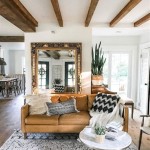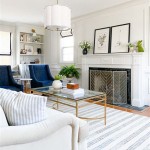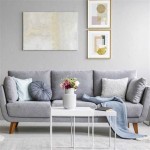How To Mix and Match Living Room Furniture: A Comprehensive Guide
Designing a living room that reflects personal style and provides functional comfort often involves carefully selecting furniture. Instead of adhering to matching sets, a contemporary approach embraces the art of mixing and matching. This allows for a more dynamic, personalized space. This article provides a comprehensive guide on how to effectively mix and match living room furniture, creating a cohesive and visually appealing environment.
Understanding the Principles of Harmony and Contrast
Before embarking on the process, it's crucial to understand the fundamental principles that underpin successful mixed furniture arrangements. Harmony and contrast are key elements in this process. Harmony refers to the consistent use of similar elements to create a sense of unity; contrast highlights differences to add visual interest. Effective mixing relies on a balanced interplay of both.
One aspect of harmony involves repeating a color or texture throughout the room. This could be as simple as incorporating a similar shade of blue in the sofa cushions, artwork, and rug. Repetition ensures that individual pieces relate to each other, even if they are stylistically different.
Contrast, on the other hand, prevents a room from appearing monotonous. This might involve juxtaposing a sleek, modern coffee table with a more traditional, upholstered armchair. The contrasting styles provide visual interest and prevent the space from feeling predictable.
Scale and proportion are also essential considerations. Ensure that the size of the furniture pieces is appropriate for the room's dimensions. A large, overstuffed sofa may visually overwhelm a small living room. Conversely, small, delicate furniture may appear lost in a large, open space.
Finally, the arrangement of furniture plays a crucial role in achieving a balanced look. Consider factors such as traffic flow, focal points, and conversation areas when positioning furniture. A well-planned layout ensures that the space is both functional and visually appealing.
Strategies for Mixing Styles, Materials, and Textures
The mixing of styles, materials, and textures is where creativity can truly shine. However, it's important to approach this process with a degree of strategy. Consider these strategies to successfully blend diverse elements.
Start by identifying a dominant style. This style will act as the foundation for the room's aesthetic. For example, if you prefer a contemporary style, you might select a modern sofa as the anchor piece. Then, introduce elements from other styles in smaller doses. A vintage side table or a traditional rug can add character without overwhelming the contemporary foundation.
Material selection is another critical aspect. Combining different materials can create a visually interesting and tactile environment. Consider pairing a leather sofa with a wooden coffee table or a velvet armchair with a metal side table. The contrast in textures and materials adds depth and complexity to the design.
Texture plays a vital role in creating a comfortable and inviting space. Layering different textures, such as smooth leather, rough linen, and soft velvet, can add warmth and visual interest. Mixing textures can also help to balance out the different styles and materials used in the room.
When mixing patterns, proceed with caution. Too many competing patterns can create a chaotic look. A good rule of thumb is to choose one or two dominant patterns and then use smaller, more subtle patterns to complement them. Ensure that the patterns share a common color or theme to create a sense of cohesion.
Color palettes also significantly influence the overall look. A cohesive color palette can tie together disparate styles and materials. Choose a primary color and then use complementary colors to add depth and visual interest. Neutral colors can provide a calming backdrop for more vibrant accent colors.
Practical Tips for Achieving a Cohesive Look
Achieving a cohesive look when mixing and matching furniture requires careful planning and attention to detail. These practical tips can help you create a harmonious and stylish living room.
Begin with a mood board. Gather images of living rooms that inspire you. This will help you visualize the overall aesthetic you're aiming for. Include images of furniture, colors, textures, and accessories that you like. A mood board provides a visual guide throughout the design process.
Consider the existing architecture of the room. The room's architectural style should influence your furniture choices. A modern apartment may benefit from sleek, minimalist furniture, while a traditional house may be better suited for more ornate pieces.
Invest in a few key pieces. Instead of trying to replace all of your furniture at once, focus on investing in a few high-quality pieces that you truly love. These pieces will serve as the foundation for your living room's design.
Use accessories to tie the room together. Accessories such as cushions, throws, and artwork can help to bridge the gap between different styles and materials. Choose accessories that complement the overall color palette and style of the room.
Pay attention to the details. The small details can make a big difference in the overall look of the room. Consider the hardware on your furniture, the trim on your curtains, and the style of your lamps. These details can help to create a cohesive and polished look.
Don't be afraid to experiment. Mixing and matching furniture is a process of trial and error. Don't be afraid to try new things and see what works best for your space. If something doesn't look right, don't be afraid to change it. The goal is to create a living room that reflects your personal style and provides functional comfort.
Consider the functionality of the space. The furniture should be chosen not only for its aesthetic appeal but also for its functionality. Ensure that the furniture is comfortable and practical for your needs. Consider factors such as seating capacity, storage space, and ease of maintenance.
Take photographs of your room throughout the design process. This will help you to see how the different elements are coming together and identify any areas that need improvement. It allows you to objectively assess your progress and make informed decisions.
Seek inspiration from unexpected sources. Look beyond traditional furniture stores and design magazines for inspiration. Explore art galleries, antique shops, and flea markets for unique and interesting pieces. Consider incorporating vintage or repurposed items to add character and personality to your living room.
Ultimately, the best way to mix and match living room furniture is to trust your instincts and create a space that you love. By following these tips and strategies, you can create a living room that is both stylish and comfortable, reflecting your unique personality and taste.

50 Ideas To Mix And Match Living Room Furniture Digsdigs

How To Mix And Match Your Sofas Chairs Swyft

Mixed Furniture A Designer S Guide To Mixing Styles Decorilla Online Interior Design

5 Expert Tips For Mixing Furniture A Curated And Cohesive Look

Mixed Furniture A Designer S Guide To Mixing Styles Decorilla Online Interior Design

How To Mix And Match Furniture Like A Pro Decoholic
:strip_icc()/cdn.cliqueinc.com__cache__posts__260338__mixing-furniture-styles-260338-1528832898364-image.700x0c-6429551ee1e34bdb89320377a2c1e60e.jpg?strip=all)
7 Foolproof Tips For Mixing Furniture Styles

Go Ahead Mix And Match Your Furniture Gulf Coast Woman Magazine

How To Mix And Match Furniture Like A Pro Interior Design Tips

3 Tips To Mix Match What You Have Get The Style Want Inspired Room








